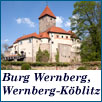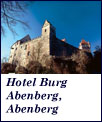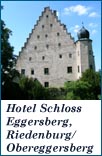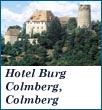Castle Hotels of Bavaria
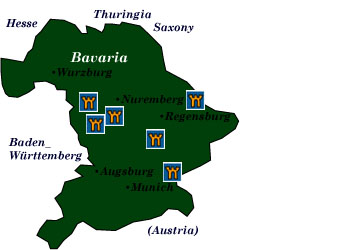
![]() Hotel Burg Abenberg
Hotel Burg Abenberg
![]() Hotel Burg Colmberg
Hotel Burg Colmberg
![]() Hotel Schloss Eggersberg
Hotel Schloss Eggersberg
![]() Klostergasthof Raitenhaslach
Klostergasthof Raitenhaslach
![]() Schloss Sommersdorf
Schloss Sommersdorf
Haven’t decided on a hotel yet? You can look at other available hotels in Bavaria region with Booking.com.
Bavaria contributes more to stir the imagination with its fairytale castles, enchanted forests, crystalline lakes, and soaring mountains than any other state in Germany. In fact, there are so many castles and palaces here, the government has named a “road” after them.
Independent in personality from the rest of Germany, Bavarians make much of their unique history. In 1180 Emperor Friedrich Barbarossa named a distant relative, Otto von Wittelsbach, as duke of Bavaria. This family remained in power until the end of World War I in 1918.
Inevitably, Bavaria was swept into the German Reich. Following World War II, Bavaria once again asserted its independence by refusing to ratify the new constitution, and it now remains a Free State.
Bavaria was fortunate in escaping the heavy bombing that leveled much of Germany. As a result, many towns still retain their medieval feel with town walls surrounding timber-framed houses topped by steeply pitched roofs.
Some great reasons to visit
![]() Munich Full of energy and style, Munich literally just bursts at the seams with outstanding restaurants, theaters, concert halls, clubs, and museums, and according to German polls, it also tops every list as the most desirable city to live in. Top attractions are the Marienplatz, or Old City; the Alte Pinakothek, one of the world’s great art museums, which holds masterpieces by Dürer, Rubens, Rembrandt, and Van Dyck; Schloss Nymphenburg, the Wittelsbach summer palace; and the Deutsches Museum, the largest technological museum in the world, with lots of hands-on exhibits for the kids. And what is Munich without a brew at one of its world-famous beer gardens? Come in late September and early October and brace yourself to contend with over seven million other visitors who are here during Oktoberfest to consume some 6.3 million liters of beer.
Munich Full of energy and style, Munich literally just bursts at the seams with outstanding restaurants, theaters, concert halls, clubs, and museums, and according to German polls, it also tops every list as the most desirable city to live in. Top attractions are the Marienplatz, or Old City; the Alte Pinakothek, one of the world’s great art museums, which holds masterpieces by Dürer, Rubens, Rembrandt, and Van Dyck; Schloss Nymphenburg, the Wittelsbach summer palace; and the Deutsches Museum, the largest technological museum in the world, with lots of hands-on exhibits for the kids. And what is Munich without a brew at one of its world-famous beer gardens? Come in late September and early October and brace yourself to contend with over seven million other visitors who are here during Oktoberfest to consume some 6.3 million liters of beer.
![]() The Romantic Road (Romantische Strasse) is one of the most popular tourist routes in Germany. Medieval villages, walled cities, baroque palaces, and onion-shaped churches dot a 290-km stretch between the towns of Würzburg in the north and Füssen in the Bavarian Alps. Even though it’s wildly popular with the tour bus crowd, the museum town of Rothenburg still retains its magic.
The Romantic Road (Romantische Strasse) is one of the most popular tourist routes in Germany. Medieval villages, walled cities, baroque palaces, and onion-shaped churches dot a 290-km stretch between the towns of Würzburg in the north and Füssen in the Bavarian Alps. Even though it’s wildly popular with the tour bus crowd, the museum town of Rothenburg still retains its magic.
![]() Mad King Ludwig II’s Fantasyland castles Appearing on every Germany tour poster on earth, Neuschwanstein is the fantasy castle built by the tragic figure of King Ludwig II. Although construction took 17 years, he only lived in his confection for 172 days. Hohenschwangau Castle is his boyhood home, and Schloss Linderhof is his French rococo palace near Oberammergau.
Mad King Ludwig II’s Fantasyland castles Appearing on every Germany tour poster on earth, Neuschwanstein is the fantasy castle built by the tragic figure of King Ludwig II. Although construction took 17 years, he only lived in his confection for 172 days. Hohenschwangau Castle is his boyhood home, and Schloss Linderhof is his French rococo palace near Oberammergau.
![]() Perfectly preserved medieval cities of Bamburg and Regensberg Bamburg, a UNESCO World Heritage Site, is considered one of Germany’s most beautiful cities (additionally, there are some 90 breweries in the environs), and Regensberg, having escaped World War II bombing, boasts over 1,500 landmarks, .
Perfectly preserved medieval cities of Bamburg and Regensberg Bamburg, a UNESCO World Heritage Site, is considered one of Germany’s most beautiful cities (additionally, there are some 90 breweries in the environs), and Regensberg, having escaped World War II bombing, boasts over 1,500 landmarks, .
![]() Berchtesgaden and the Königssee Although Berchtesgaden is often associated with the infamous “Eagle’s Nest” of Adolf Hitler, there is much more to do and see here. Half the area is protected national park and home to the Königssee, Germany’s highest lake. A boat tour on the lake is utterly delightful.
Berchtesgaden and the Königssee Although Berchtesgaden is often associated with the infamous “Eagle’s Nest” of Adolf Hitler, there is much more to do and see here. Half the area is protected national park and home to the Königssee, Germany’s highest lake. A boat tour on the lake is utterly delightful.
![]() The Bavarian forest (Bayerischer Wald) Dense forests, streams, lakes, and meadows make up part of a mystical atmosphere right out of a fairytale. The National Park Bayerischer Wald was Germany’s first. It now blends with the larger Sumava National Park on the Czech Republic’s side, forming the largest continual woodland in Europe.
The Bavarian forest (Bayerischer Wald) Dense forests, streams, lakes, and meadows make up part of a mystical atmosphere right out of a fairytale. The National Park Bayerischer Wald was Germany’s first. It now blends with the larger Sumava National Park on the Czech Republic’s side, forming the largest continual woodland in Europe.
![]() The Castle Road (Burgenstrasse) German tourism promotes dozens of “roads” to encourage visitors to discover some of the less known areas of Germany. The Castle Road travels 975 km from Mannheim to Prague in the Czech Republic, passing by some 70 fortresses, ruins, and castles.
The Castle Road (Burgenstrasse) German tourism promotes dozens of “roads” to encourage visitors to discover some of the less known areas of Germany. The Castle Road travels 975 km from Mannheim to Prague in the Czech Republic, passing by some 70 fortresses, ruins, and castles.
![]() Garmisch-Partenkirchen If you’re traveling in Bavaria in winter, the tallest mountain in Germany, the Zugspitze, offers plenty of ski slopes. In summer, hiking along mountain meadows and gorges is superb.
Garmisch-Partenkirchen If you’re traveling in Bavaria in winter, the tallest mountain in Germany, the Zugspitze, offers plenty of ski slopes. In summer, hiking along mountain meadows and gorges is superb.
